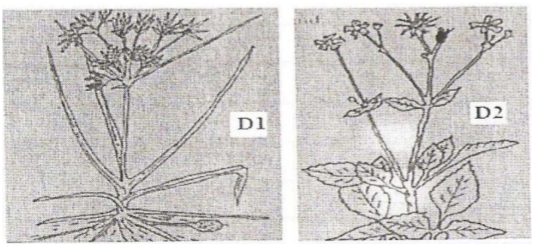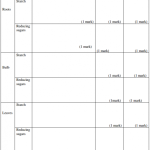KNEC KCSE Agriculture Paper 1 Question Paper / 2016 Pre KCSE
2016 Pre KCSE
Agriculture Paper 1
SECTION A (30 Marks)
Answer all questions in this section
Name two crops grown in Kenya for the fresh flower export market.
………………………………………………………………………………………………
………………………………………………………………………………………………
………………………………………………………………………………………………
1 marks
Name four communication channels through which farmers’ access knowledge on
farming.
………………………………………………………………………………………………
………………………………………………………………………………………………
………………………………………………………………………………………………
………………………………………………………………………………………………
………………………………………………………………………………………………
2 marks
State four ways in which burning leads to loss of fertility.
………………………………………………………………………………………………
………………………………………………………………………………………………
………………………………………………………………………………………………
………………………………………………………………………………………………
………………………………………………………………………………………………
2 marks
a) Define the term minimum tillage. (1/2 mk)
………………………………………………………………………………………………
………………………………………………………………………………………………
………………………………………………………………………………………………
b) Name any four farming practices involved in minimum tillage. (2 marks)
………………………………………………………………………………………………
………………………………………………………………………………………………
………………………………………………………………………………………………
2.5 marks
a) List three types of individual land tenure systems. (1 ½ mks)
………………………………………………………………………………………………
………………………………………………………………………………………………
………………………………………………………………………………………………
b) Define co-operative land tenure system. (1/2 mk)
………………………………………………………………………………………………
………………………………………………………………………………………………
2 marks
a) Give two differences between a dam and a weir. (1 mark)
| dam | weir |
| | |
| | |
b) List two surface water sources for farming. (1 mark)
………………………………………………………………………………………………
………………………………………………………………………………………………
………………………………………………………………………………………………
2 marks
State four ways in which treating water makes the water fit for use on farm.
………………………………………………………………………………………………
………………………………………………………………………………………………
………………………………………………………………………………………………
2 marks
a) Define leaching. (1/2 mk)
………………………………………………………………………………………………
………………………………………………………………………………………………
………………………………………………………………………………………………
b) Give three benefits of deep soil to a crop. (1 ½ mks)
………………………………………………………………………………………………
………………………………………………………………………………………………
………………………………………………………………………………………………
2 marks
Give three benefits of spacing maize plants widely.
………………………………………………………………………………………………
………………………………………………………………………………………………
………………………………………………………………………………………………
1.5 marks
State four reasons for conserving forage.
………………………………………………………………………………………………
………………………………………………………………………………………………
………………………………………………………………………………………………
2 marks
State two ways in which pruning tomatoes helps to control diseases in this crop.
………………………………………………………………………………………………
………………………………………………………………………………………………
………………………………………………………………………………………………
1 marks
Explain each of the following:
a) Slopy land requires little number of cultivations. (1/2 mk)
………………………………………………………………………………………………
………………………………………………………………………………………………
b) A field with rhizomatous weeds requires deep cultivation. (1/2 mk)
………………………………………………………………………………………………
………………………………………………………………………………………………
c) Irish potatoes are raised on ridges, rather than on leveled land (1/2 mk)
………………………………………………………………………………………………
………………………………………………………………………………………………
1.5 marks
State four reasons for carrying out primary tillage.
………………………………………………………………………………………………
………………………………………………………………………………………………
………………………………………………………………………………………………
2 marks
State two positive effects of winds on agriculture.
………………………………………………………………………………………………
………………………………………………………………………………………………
………………………………………………………………………………………………
1 marks
Distinguish between seed dressing and seed inoculation.
………………………………………………………………………………………………
………………………………………………………………………………………………
1 marks
State two ways in which soil pH3 can be raised to pH6.5
………………………………………………………………………………………………
………………………………………………………………………………………………
………………………………………………………………………………………………
1 marks
Name any three insect pests with biting and chewing mouthparts.
………………………………………………………………………………………………
………………………………………………………………………………………………
………………………………………………………………………………………………
1.5 marks
Name any four early maturing varieties of cabbages. ………………………………………………………………………………………………
………………………………………………………………………………………………
………………………………………………………………………………………………
2 marks
SECTION B (20 Marks)
Answer all questions in this section in the spaces provided.
Shown below is a layout of a compost heap. Study it carefully and then answer the
questions that follow.
a) Name the materials in each of the parts labeled 1, 2, 3 and 4. (2 marks)
1………………………………………………….3……………………………………..
2………………………………………………….4……………………………………..
b) State one role of each of the material in the parts labeled 1 and 3. (2 marks)
1………………………………………………………………………………………….
2…………………………………………………………………………………………..
c) (i) Give one reason for adding water to a compost heap. (1mark)
………………………………………………………………………………………………
………………………………………………………………………………………………
(ii) Give one reason for regularly turning the materials in a compost heap (1 mark)
………………………………………………………………………………………………
………………………………………………………………………………………………
6 marks
The diagram below illustrates a field management practice carried out on a fruit crop.
a) Identify the practical illustrated above. (1 mark)
………………………………………………………………………………………………
………………………………………………………………………………………………
b) Name the most likely crop managed as illustrated in the above. (2 marks)
………………………………………………………………………………………………
………………………………………………………………………………………………
c) Give two reasons for carrying out the practice illustrated above. (2 marks)
………………………………………………………………………………………………
………………………………………………………………………………………………
d) Name one other method of training crops apart from the one above. (1 mark)
………………………………………………………………………………………………
………………………………………………………………………………………………
6 marks
Illustrated below are crop pests. Study the illustrated above. (2 marks)
a) Identify each of the pests labeled G, G, and H. (1 ½ mks)
F……………………………………………………………………………………..
G…………………………………………………………………………………….
H…………………………………………………………………………………….
b) State two types of damage caused by pest G to the crops infested. (1 mark)
………………………………………………………………………………………………
………………………………………………………………………………………………
………………………………………………………………………………………………
c) The diagram below shows a vegetable fruit which has been attacked by pests:
i) Name the pest shown above. (1/2 mk)
………………………………………………………………………………………
………………………………………………………………………………………
ii) Give one control measure for the above pest. (1 mark)
………………………………………………………………………………………
………………………………………………………………………………………
iii) Name two other pests that affect the same crop. (1 mark)
………………………………………………………………………………………………
………………………………………………………………………………………………
………………………………………………………………………………………………
7 marks
Shown below are diagrams of weeds of arable land.
a) Identify each weed D1 and D2 (1 mark)
D1……………………………………………………………………………………….
D2…………………………………………………………………………………………
b) Explain why herbicide application is ineffective in controlling the weed labeled D1.
(2 marks)
………………………………………………………………………………………………
………………………………………………………………………………………………
………………………………………………………………………………………………
3 marks
SECTION C (40 Marks)
Answer any two questions in this section
a) Differentiate between land fragmentation and land sub-division (2 marks)
b) Describe the effects of land fragmentation and sub-division (8 marks)
c) Explain the various cultural methods used to control diseases of crops
(10 marks)
20 marks
a) Outline five effects of temperature on crops. (5 marks)
b) Describe five factors which influence soil formation. (5 marks)
c) Describe ten factors which determine the type of irrigation chosen by a farmer.
(10 marks)
20 marks
a) Explain four factors considered in designing a crop rotation programme (8 marks)
b) Describe five benefits of intercropping food crops. (5 marks)
c) Outline seven post-harvest practices carried out in the production of maize. (7 marks)
20 marks









